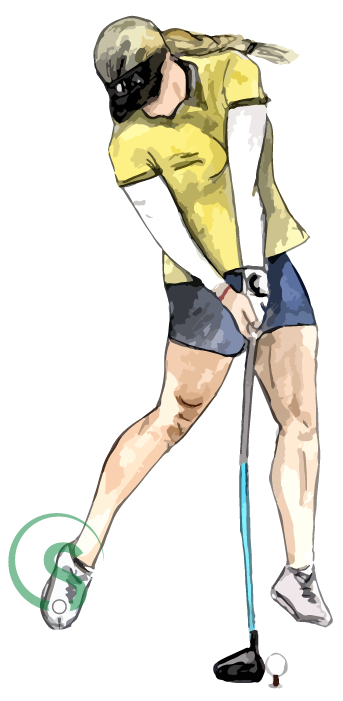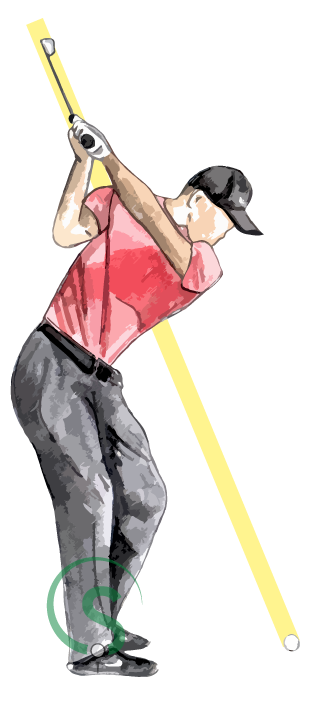Imperatives
The Three Basic Imperatives are: a “flat” left wrist, a clubhead lag pressure point, and a straight plane line.
A "Flat" Left Wrist
A flat left wrist occurs when the back of the left hand and the left forearm are in line.(1) This alignment holds the clubshaft and left arm in a straight line. This is best viewed from a “face on” perspective when the left arm is vertical, usually just after impact. If a golfer is performing the first imperative correctly, at this point you would see a straight line from the left shoulder, down to the clubhead.
The flat left wrist is only necessary during impact.(2) Prior to or after hitting the ball, this alignment needn’t exist. You’ll note the word “flat” is in quotation marks. This is because, depending on your grip type, the left wrist doesn’t have to be flat at all, but in its equivalent alignment whereby the clubshaft and left arm are in the aforementioned straight line. The crux of the first imperative is to not allow the clubhead to overtake the hands through impact by bending the left wrist (i.e. reducing the angle between the back of the left hand and the left forearm - in anatomical terms, wrist extension).(3) The reason this is so important is explained with a concept named “The Flail”.(4)
A flail is traditionally two sticks of wood attached together by a rope or chain. It was a farming tool used to beat the grain from crops. Nunchaku, the martial arts weapon, is also a flail. Flails work by transferring momentum from the stick you’re holding to the second stick attached by rope or chain. By transferring momentum this way, you can greatly increase the speed of the second stick, compared to the first. The golf swing is also a flail, where your left arm is the first stick, the golf club is the second, and your left wrist is the rope or chain connecting the two. Swinging your left arm transfers momentum to the golf club, greatly increasing the speed of the clubhead compared to the speed of your left hand. When swinging a flail, be it an agricultural tool, weapon, or your left arm and golf club, the “second stick” is always trying to move in line with the “first stick”. This gives rise to a concept Mr Kelley called “The Law of the Flail”. The Law of the Flail notes three alignments during the swing, and describes what is happening to the second stick (the “swingle”, as Mr Kelley refers to it) at each position.
The flat left wrist is only necessary during impact.(2) Prior to or after hitting the ball, this alignment needn’t exist. You’ll note the word “flat” is in quotation marks. This is because, depending on your grip type, the left wrist doesn’t have to be flat at all, but in its equivalent alignment whereby the clubshaft and left arm are in the aforementioned straight line. The crux of the first imperative is to not allow the clubhead to overtake the hands through impact by bending the left wrist (i.e. reducing the angle between the back of the left hand and the left forearm - in anatomical terms, wrist extension).(3) The reason this is so important is explained with a concept named “The Flail”.(4)
A flail is traditionally two sticks of wood attached together by a rope or chain. It was a farming tool used to beat the grain from crops. Nunchaku, the martial arts weapon, is also a flail. Flails work by transferring momentum from the stick you’re holding to the second stick attached by rope or chain. By transferring momentum this way, you can greatly increase the speed of the second stick, compared to the first. The golf swing is also a flail, where your left arm is the first stick, the golf club is the second, and your left wrist is the rope or chain connecting the two. Swinging your left arm transfers momentum to the golf club, greatly increasing the speed of the clubhead compared to the speed of your left hand. When swinging a flail, be it an agricultural tool, weapon, or your left arm and golf club, the “second stick” is always trying to move in line with the “first stick”. This gives rise to a concept Mr Kelley called “The Law of the Flail”. The Law of the Flail notes three alignments during the swing, and describes what is happening to the second stick (the “swingle”, as Mr Kelley refers to it) at each position.
- The First Law of the Flail:
While the swingle is seeking its in-line position (full extension) relation with the handle, there is “centrifugal acceleration”. - The Second Law of the Flail:
When it becomes in-line, this settles into “centrifugal angular momentum” (full extension). - The Third Law of the Flail:
If it passes its in-line relation it again seeks its in-line relation (backs up) and “centrifugal deceleration” sets in with a huge power loss.

Let’s cast our minds back to what Mr Kelley called the secret of golf: sustaining the line of compression. We can’t maintain compression of the golf ball if the clubhead is slowing down during impact. Once the left wrist starts to bend and the Third Law of the Flail is in effect, the deceleration is quite dramatic; resulting in a clubhead traveling at over 100mph during a full swing to come to a complete stop in less than a second. A “flat” left wrist (or equivalent) at impact prevents this deceleration from occurring and helps facilitate the clubhead accelerating through impact.
A Clubhead Lag Pressure Point
Clubhead lag isn’t, as many assume, just the clubhead trailing behind the hands. More importantly it’s the bending of the clubshaft as the clubhead resists the change in direction and / or velocity at the start of the downswing.(5) We’d learnt from the Law of the Flail how by maintaining the flat left wrist through impact we can avoid the clubhead decelerating. A flat left wrist however, is no guarantee of “sustaining the line of compression”.
In order to master the secret of golf and sustain the line of compression during impact, we must accelerate the clubhead as it collides with the ball. This acceleration stresses the clubshaft creating clubhead lag.(6)
Clubhead lag is essential because during impact the clubhead exerts a force on the ball, but the ball exerts an equal and opposite force on the clubhead.(7) If the clubshaft isn’t flexed during the impact interval, it will flex because of the impact, softening the blow, decelerating the clubhead and make sustaining compression impossible. As Mr Kelley explains: “The prestressed clubshaft will resist the added weight of the ball during impact, instead of cushioning the impact with an unstressed clubshaft.”(8)
We can use our hands to feel where the club is and how it’s behaving during the swing. This is an important concept in The Golfing Machine, one Mr Kelley refers to as having “Educated Hands”.(9) In order to accelerate the clubhead and bend the clubshaft, we must apply force to the club. Where we apply this force we can feel pressure in our hands(10) as the clubhead resists the change in velocity.(11) So long as we can feel this clubhead lag pressure, we can be sure the clubshaft remains flexed and the clubhead is accelerating.
You may be wondering why we are accelerating the clubhead through impact rather than trying to hit the ball at our maximum speed. Mr Kelley explains: “'Right' timing is not a matter of PEAK SPEED because there really isn’t any - just a steady build-up of momentum.” He goes on to say: “Acceleration ceases when the speed it has produced equals that of the thrust, and though the thrust is still present and able to maintain velocity, it loses the flexed, stressed clubshaft (Hitters) and the wallop of the centrifugal force (Swingers).”(12)
In addition to the above explanation, we can educate our hands to feel acceleration via pressure points, but we cannot educate our hands to differentiate between maximum speed and deceleration. They both produce no pressure in our hands, and so feel the same.
In order to master the secret of golf and sustain the line of compression during impact, we must accelerate the clubhead as it collides with the ball. This acceleration stresses the clubshaft creating clubhead lag.(6)
Clubhead lag is essential because during impact the clubhead exerts a force on the ball, but the ball exerts an equal and opposite force on the clubhead.(7) If the clubshaft isn’t flexed during the impact interval, it will flex because of the impact, softening the blow, decelerating the clubhead and make sustaining compression impossible. As Mr Kelley explains: “The prestressed clubshaft will resist the added weight of the ball during impact, instead of cushioning the impact with an unstressed clubshaft.”(8)
We can use our hands to feel where the club is and how it’s behaving during the swing. This is an important concept in The Golfing Machine, one Mr Kelley refers to as having “Educated Hands”.(9) In order to accelerate the clubhead and bend the clubshaft, we must apply force to the club. Where we apply this force we can feel pressure in our hands(10) as the clubhead resists the change in velocity.(11) So long as we can feel this clubhead lag pressure, we can be sure the clubshaft remains flexed and the clubhead is accelerating.
You may be wondering why we are accelerating the clubhead through impact rather than trying to hit the ball at our maximum speed. Mr Kelley explains: “'Right' timing is not a matter of PEAK SPEED because there really isn’t any - just a steady build-up of momentum.” He goes on to say: “Acceleration ceases when the speed it has produced equals that of the thrust, and though the thrust is still present and able to maintain velocity, it loses the flexed, stressed clubshaft (Hitters) and the wallop of the centrifugal force (Swingers).”(12)
In addition to the above explanation, we can educate our hands to feel acceleration via pressure points, but we cannot educate our hands to differentiate between maximum speed and deceleration. They both produce no pressure in our hands, and so feel the same.
A Straight Plane Line
This imperative relates to the clubshaft’s path throughout the swing. Mr Kelley states in The Golfing Machine: “All the action of the golf club takes place on a flat, inflexible, inclined plane which extends well beyond the circumference of the stroke - in every direction. The full length of the clubshaft remains unwaveringly on the face of this inclined plane - waggle to followthrough.”(13) In layman’s terms, you should be swinging the club in a circle. This sounds obvious, but consider what a circle actually is: a two-dimensional shape. Swinging the club on plane is the hardest of the imperatives to master. Whereas the “flat” left wrist and clubhead lag pressure points can be learnt and assimilated into your swing relatively quickly, the third imperative will take considerably longer to perform properly. This is because, whereas the first two imperatives are single components of your swing(14), keeping the clubshaft on plane is orchestrated through all of your swing’s components.

The plane line Mr Kelley refers to is the line traced along the ground by the clubshaft during the swing.(15) If this traced line is straight, as opposed to curved, then we can be sure the golf club is being swung on a two-dimensional plane. Mr Kelley states: “If the Plane Line loses its straightness, the Clubhead Orbit becomes three dimensional, spherical and precision vanishes.”
